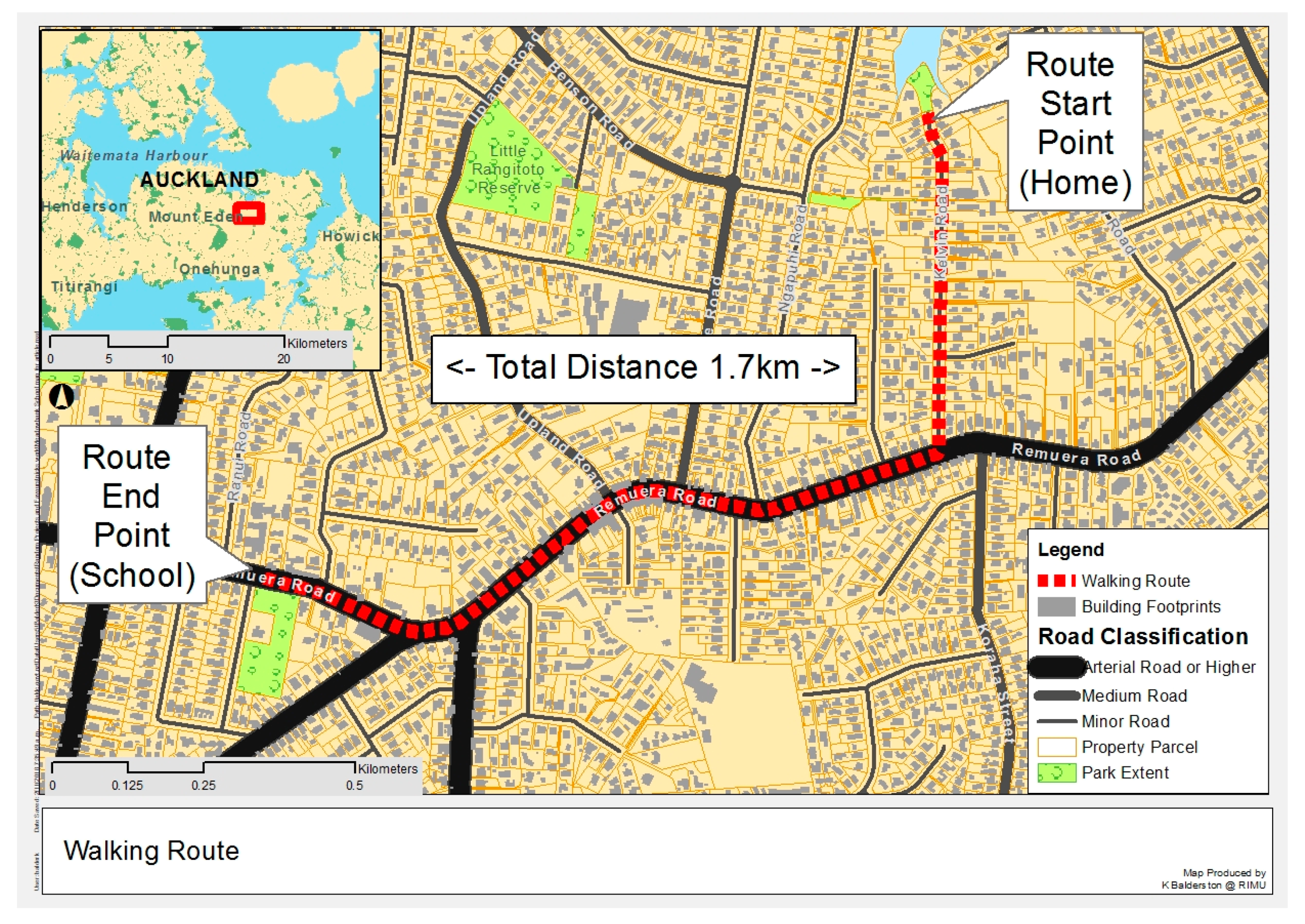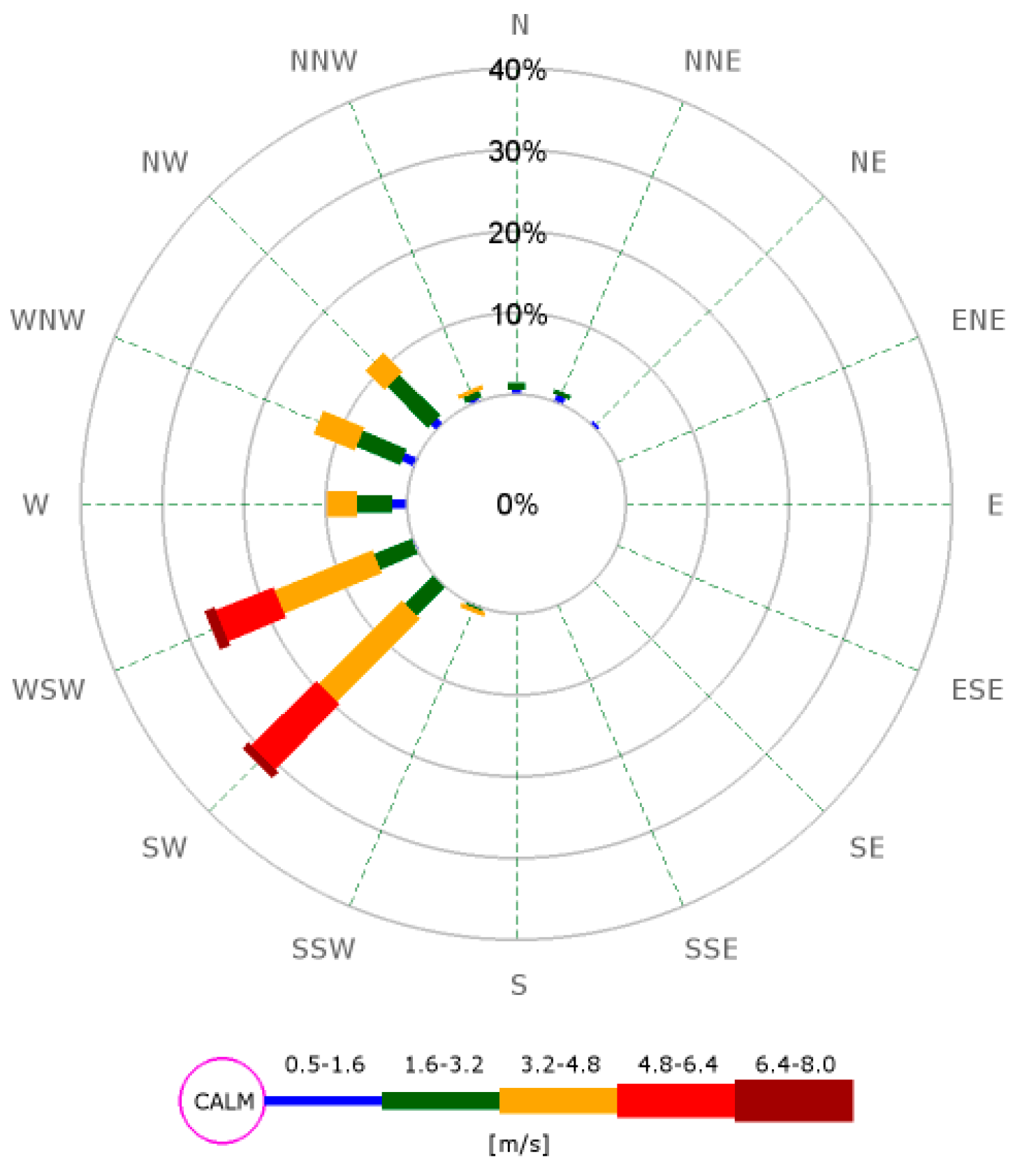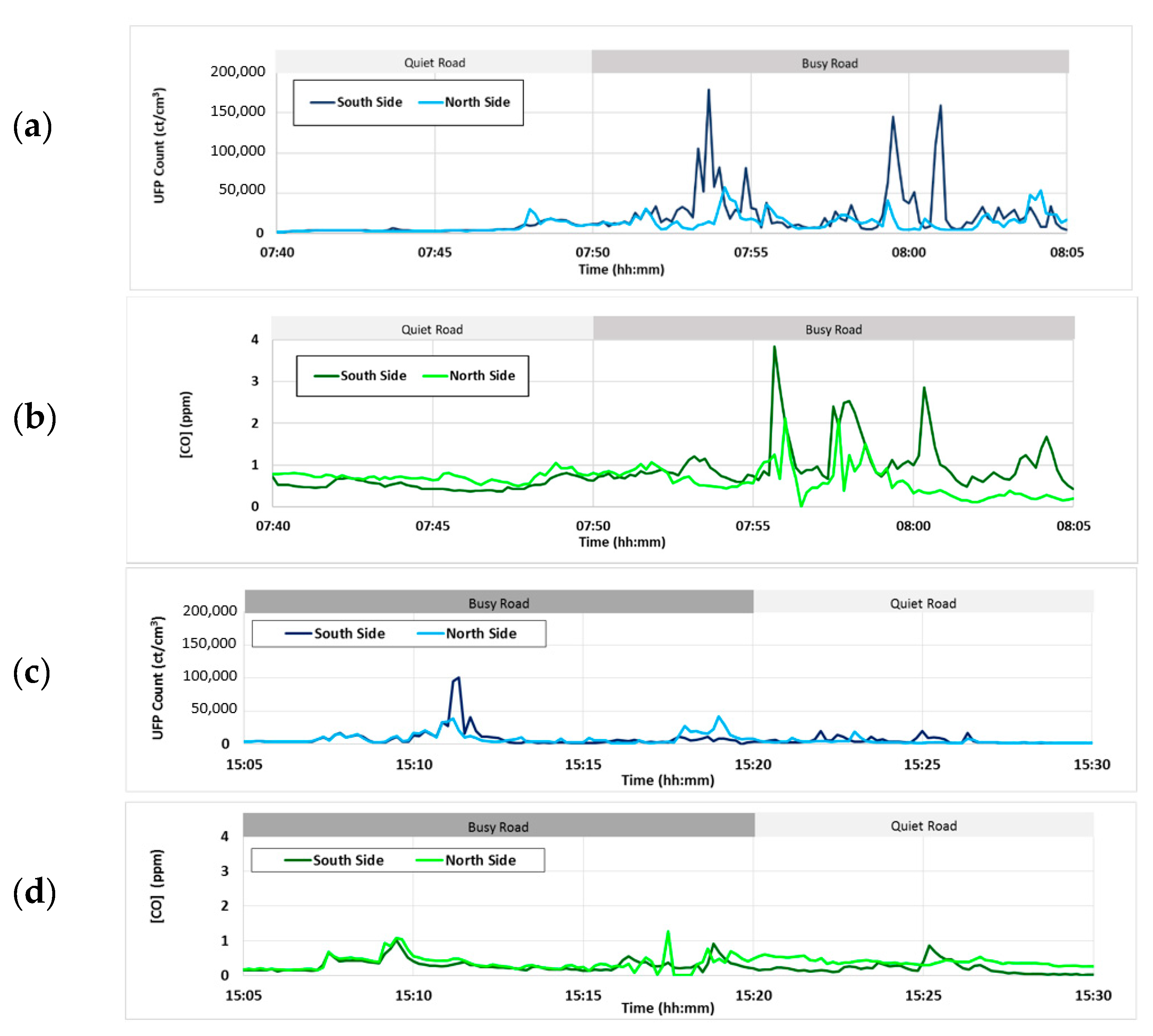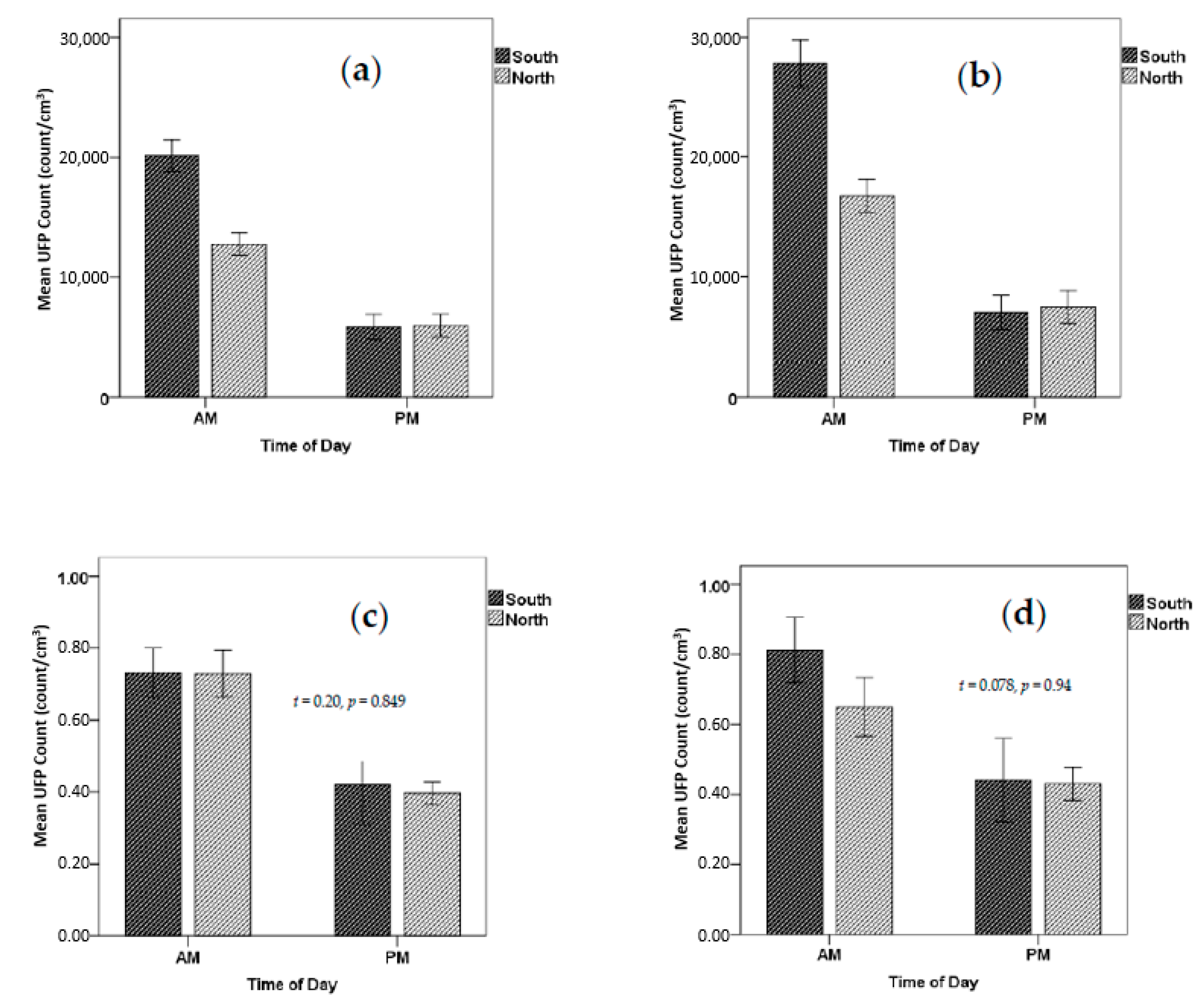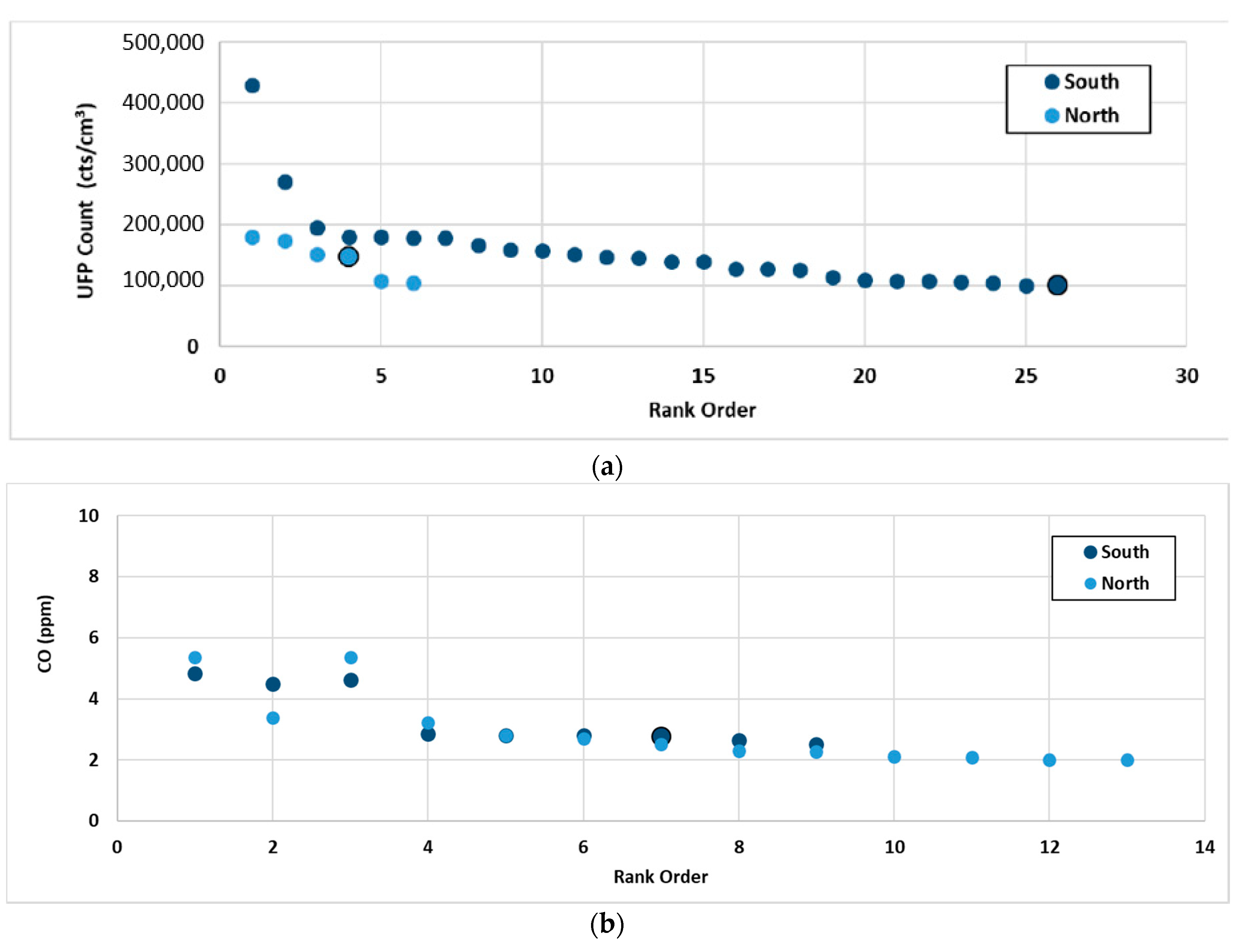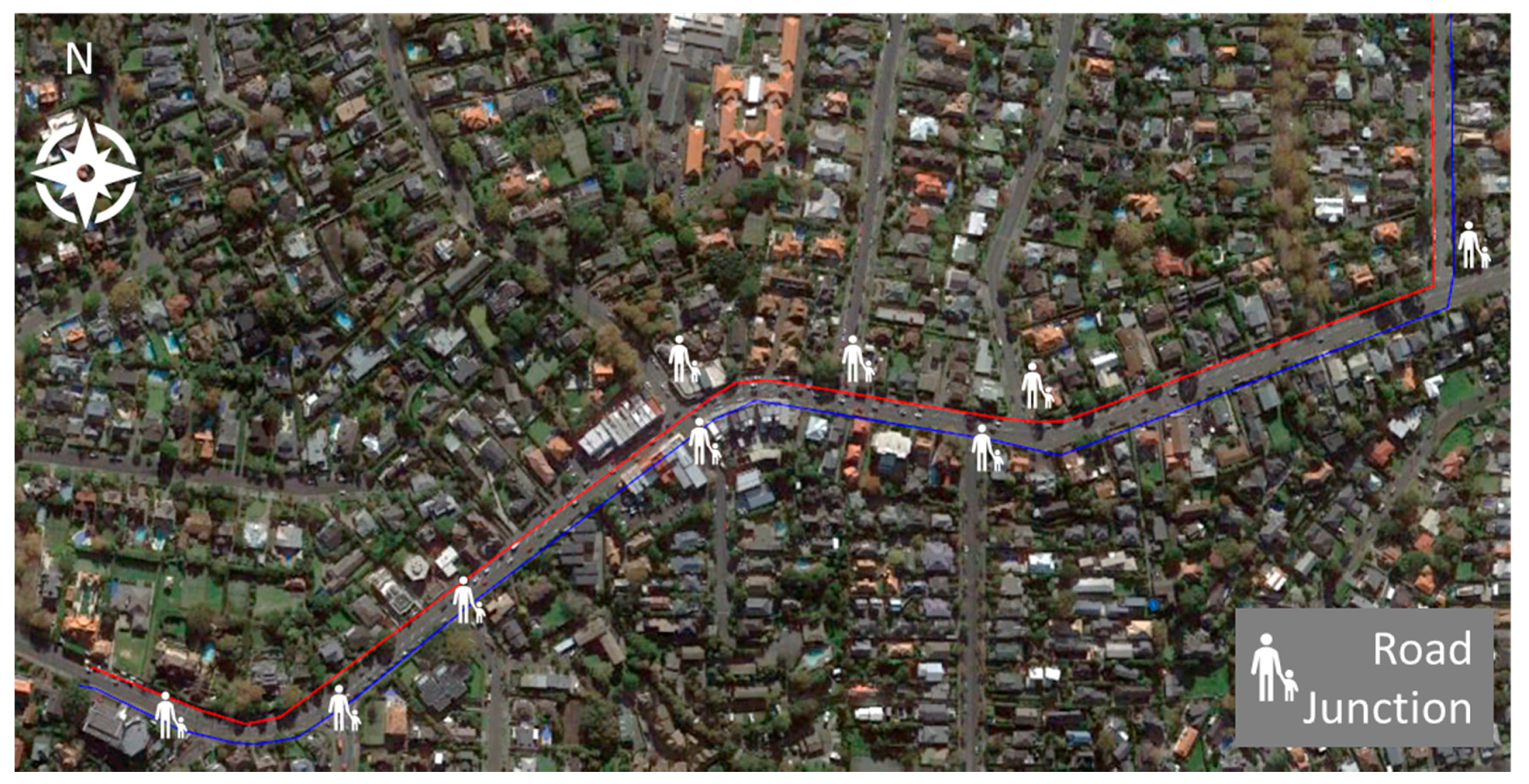1. Introduction
Regular engagement in physical activity is vital for good health and well-being. The New Zealand Ministry of Health recommends that children aged 5 to 16 years engage in at least one hour of moderate or vigorous aerobic exercise each day and that children stay active as much as possible, including when travelling from place to place [
1]. Walking to school is one way to help children reach their daily recommended level of physical activity and generally help them to stay active. Other benefits of walking to school include the enjoyment of it, the opportunity for increased social cohesion with classmates, the opportunity to learn about road traffic safety, the encouragement of walking as a normal activity [
2], as well as reducing traffic congestion around schools [
3]. While many children are now driven to school, there is evidence that many children from cities, including those in the UK and in New Zealand, would prefer to walk to school rather than be driven if given the opportunity to choose [
2,
4].
Despite all of the benefits, the uptake of walking to school remains relatively low across much of the developed world. For example, in Auckland, New Zealand, 40% of primary school aged children walk to school [
5], despite most children living in very close proximity to their local school. It has also been noted that children more often walk home from school in the afternoon than walk to school in the morning. This is believed to be due to the morning commute being more often linked to the parents travelling to work [
2].
A significant literature now exists around the barriers associated with walking to school amongst primary school-aged children. This includes studies into the risk of traffic-related accidents, as well as concerns around ‘stranger danger’ [
6]. The need for solutions to alleviate these fears has led to the development of organized walking groups, coined walking school buses (WSBs), or Walk to School programmes, whereby children walk in groups to school, accompanied by adults, along a pre-specified route chosen based largely on catchment need, traffic safety considerations, parental participation and motivation to ‘drive’ the school buses. Such groups have become popular around the world, including in the UK where they were first proposed [
7], as well as across New Zealand [
6]. As of 2006, 83 schools across New Zealand had at least one WSB route registered, with participating schools tending to be concentrated in the wealthier neighborhoods [
3].
One factor generally not taken into account in walking school bus route planning is the air pollution exposure experienced by children during their commute. There is mounting evidence in the literature of the association between exposure to traffic-related pollution and adverse health outcomes, including cancer [
8]. Traffic air pollution has also been linked to a range of respiratory-related conditions, including the exacerbation of asthma amongst both children and adults [
9]. While all people are at risk when exposed to traffic pollutants, children have been found to be more susceptible to adverse effects than adults [
10].
Given that traffic-related air pollution exposure has been linked to both acute health effects triggered by short periods of elevated exposures, and chronic health effects resulting from cumulative effects over extended periods of time [
8], an effort should be made to avoid both peaks in exposure as well as minimizing the cumulative exposures experienced during high exposure activities such as commuting. In the case of walking to school, children have the potential to be exposed to elevated levels of air pollution over a long period of time (five days a week for many days of the year over many years) at a time in their lives when they are most vulnerable. The close proximity to roads and the lack of a physical barrier between exhaust pipes and respiratory systems also make pedestrians vulnerable to peaks in air pollution concentrations [
11].
Concentrations of traffic-related air pollutants along road corridors are influenced by the traffic flow rate, state of congestion, as well as the local meteorology, including the wind speed and direction. In relation to the commute to school, significantly higher exposures can be expected for children walking to school in the morning compared with during their journey home because of the timing in relation to ‘rush hour’ traffic and also because of the more effective dispersion conditions that tend to exist in the middle of the afternoon compared with the early morning due to higher wind speeds.
The air pollution doses experienced by commuters travelling along a given route will depend not only on the pollutant concentrations in the road corridor but also the time spent commuting. The separation of the commuter relative to the main line of traffic has been found to have a significant influence on exposure with the larger the separation from the traffic, the lower the exposure [
12]. In fact, a recent study carried out on a busy street in London showed that pedestrians travelling at the building edge of the footpath within a street canyon experienced significantly lower exposures than those walking on the footpath close to the road edge [
13]. While for some journeys there are options available for avoiding congested roads altogether, other journeys involve roads with congestion that are impossible to avoid, for example, in the case of a school located along a main arterial road with that road being the only access to the school. In this case, especially if the route is dominated by traffic in one direction (‘rush hour’ traffic), the side of the road on which children walk could have a significant impact on their air pollution dose because of the difference in the separation of the walker from the lane of traffic with the greatest amount of congestion.
The aim of this paper is to determine, through field work, the extent to which the air pollution doses (in this case, ultrafine particle (UFP) counts, and carbon monoxide (CO) concentrations) of walk-to-school commuters can be reduced by the careful selection of the best side of the road to travel to avoid walking on the footpath closest to the more congested side of the road. This has been carried out by measuring the air pollution exposure for two hypothetical walk-to-school commuters travelling on either side of a road simultaneously on walks both to school and on the journey home. Any strategy for reducing air pollution exposure while ensuring children continue to walk (thereby receiving the exercise and other advantages of walking) would be beneficial, both for children as well as adults partaking in the walk to school. Significant differences in exposure patterns could have implications for the planning of WSB routes to ensure the best possible environment for children partaking in walking.
4. Discussion
A London exposure study [
13] found that the path chosen along a specific footpath had a significant impact on the air pollution exposures of pedestrians. This is supported by the study undertaken by Grange et al. (2014) [
12] and others suggesting that even a modest increase in separation between traffic and active mode commuters can lead to a significant reduction in air pollution exposure. In the present study, pedestrians who travel on different sides of a road have been compared, with implications for the design of walking school bus routes for children on the way to and from school with respect to both peak and mean concentrations. A study in Spain identified diesel buses as the key source of UFP within their study. The same report also shows that the highest spikes in concentration were recorded at road junctions where vehicles were idling [
15].
Figure 6 shows the number of junctions where the WSB would have to wait to cross roads. The bus on the south side of the road must cross six roads compared to three for the north side. The number of junctions might also have increased the likelihood of receiving spikes in UFP and CO.
The journey average concentrations (
Table 3) are consistent with other Auckland-based studies investigating pedestrian exposures [
11,
12]. For example, average UFP counts for the study carried out by Dirks et al. (2012) [
11] were 15,370 counts/cm
3 and 15,267 counts/cm
3 for pedestrians on their side of the street compared to an overall mean of 12,938 counts/cm
3 in the present study. Significant increases in exposure when travelling on the more congested (south side) of the road were found for ultrafine particle concentrations during the morning commute when 60% of the traffic and most of the buses were city-bound, but not for carbon monoxide. This could be a reflection of the dominance of buses travelling city-bound in the morning; the vehicles contributing to ultrafine particle counts, but not to petrol-engine vehicles that are responsible for most of the carbon monoxide. No significant differences were found between sides of the road in terms of exposure for either ultrafine particle counts or carbon monoxide concentrations for the afternoon period. Peaks in ultrafine particle exposure were observed mainly during the morning commutes and also for commuters walking on the more congested (South) side of the road at that time of day.
Previous research carried out in Auckland has identified transport as the major contributing factor to PM
2.5 measurements [
16] whilst buses were found to contribute to plumes of UFP pollution along footpaths [
17]. Moreover, the distance from the roadside and the height of the pedestrian will also impact upon personal exposure [
18], with plume density (and therefore UFP number concentrations) higher closer to the road and lower to the ground.
This study suggests that travel along congested roads should be avoided in favor of travel along quieter streets, and that attention should be paid to the side of the road on which children walk. This will ensure that long-term exposure will be minimized as well as the likelihood of exposure to peaks in concentration.
Exposures were observed to be considerably lower in the afternoon compared with the morning. There are several mechanisms that might explain this. A noticeable increase in wind speed during the afternoon period (
Table 2) would help remove locally-emitted pollutants more rapidly than during the morning walk. Increased vertical mixing due to increased boundary layer height would also increase dilution of pollutants during the afternoon period. The number of buses in the afternoon is also reduced, helping with this reduction. The differences in exposures for the two sides of the road is also reduced in the afternoon. This can be explained, at least in part, by the evening traffic which is less dominated by flow in one direction at that time of the day compared with the morning period. The number of buses and the flow of PM traffic might also play a part in reducing concentrations. The fact that more children walk home from school [
2] rather than to school in the morning is helpful in terms of maximizing the benefits of exercise, social interaction and learning about traffic safety, while minimizing the adverse effects of air pollution exposure.
There are several limitations associated with this study. Firstly, only one route was investigated and over only a short two-week period during which time the range of meteorological conditions was relatively narrow. Every route is unique in terms of its traffic flows, traffic light phasing and local meteorology, so exposures can be expected to vary considerably from day to day and season to season. None-the-less, significant patterns emerged over the period of sampling leading to statistically significant differences in exposure due to the side of road travelled for UFP.
While the traffic data were able to reveal the proportion of heavy-duty vehicles travelling along the road, the proportion of heavy-duty traffic was not sorted by direction. As such, it was not possible to estimate the proportion of heavy-duty vehicles travelling on the more congested side of the road compared with the less congested side. Also, the traffic flows were only available as 24-h counts or by hour at peak times, in this case 5:00 pm–6:00 pm rather than 3:00 pm–4:00 pm when children travel home from school. None-the-less, observations made during the study suggest that the heavy-duty traffic consisted mostly of buses and that the majority were heading in the direction of the city during the morning commute to school, impacting on ultrafine particle concentrations and not so much on carbon monoxide.
5. Conclusions
The focus of this study has been on WSB routes as they are planned in a way that is more prescribed compared with many other walking journeys. However, it is important to note that the results of this study apply to any pedestrian route, whether walking to school or not, or whether walking in an organized group or not.
There are many factors that should be considered when planning a walking route to school for children, including pedestrian safety with respect to road accidents. However, air pollution should also be considered. The results from this study identified time of day, traffic volume with specific focus on bus concentrations, as well as the number of junctions a pedestrian might have to cross to be the main factors in deciding personal exposure to potentially hazardous air pollutants. The implications of these key findings suggest that congested roads should be avoided if possible, in favor of quieter roads to minimize personal exposure. If travel along congested roads is unavoidable, then consideration should be made of travel along the footpath on the side of the road furthest from the lane of traffic with the most congestion. Pedestrians travelling on the side opposite the more congested side avoid many short-term peaks in concentration and experience significantly lower mean exposures than those travelling on the footpath closest to the more congested traffic.
However, route planning decisions need to be weighed up against the extra time spent waiting at intersections and pedestrian crossings as pollution levels tend to be higher there than along the segment between intersections [
19]. The increased risk of accidents associated with crossing the road and the availability of suitable places to cross also need to be taken into account.
There are numerous benefits to encouraging children to walk to school. Parents should be encouraged to contribute to WSBs and other initiatives aimed at facilitating the opportunity for children to walk to school. Route choices should be based on consideration of air pollution exposure as well as catchment needs, traffic safety and travel time efficiency to maximize the health benefits and minimize the risk.
